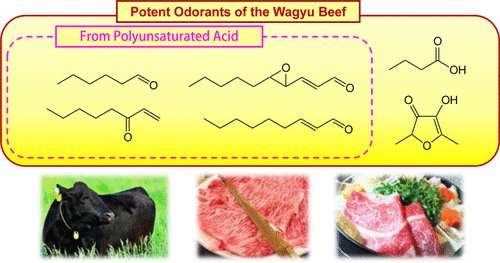Key odorants in world's most expensive beef could help explain its allure

Renowned for its soft texture and characteristic flavor, Wagyu beef—often referred to as Kobe beef in the U.S.—has become one of the world's most sought-after meats. Now in a study appearing in the Journal of Agricultural and Food Chemistry, scientists report that they have detected several key odorants that contribute to the delicacy's alluring aroma.
Considered by some to be the champagne or caviar of beef, Waygu is one of the rarest and most expensive meats in the world. It comes from Japanese Black cattle —which accounts for 95 percent of Wagyu—and three other species raised in Japan. The meat's distinctive marbling, juiciness and succulent taste are enhanced by its sweet aroma, known as "wagyuko," that has been compared to coconut or fruit. In recent years, scientists have been trying to nail down what makes Wagyu aroma distinctive from other types of beef. In one study, researchers found that one particular compound appeared to have an important influence on the meat's aroma. But the samples used in that experiment were not cooked at the optimal temperature. To get a better sense of which odorants are responsible for Wagyu's aroma, Satsuki Inagaki and colleagues decided to try a different approach.
The researchers conducted an aroma extraction dilution analysis of Matsusaka-beef (a kind of Wagyu ribeye) and grass-fed Australia beef (loin). The team heated the samples to about 175 degrees Fahrenheit to simulate optimal cooking conditions. Using gas chromatography techniques, the research team detected 10 newly identified compounds in the Wagyu beef aroma, including one previously associated with cooked chicken that had an egg-white odor. Several Wagyu compounds were also found in the Australian beef aroma. However, the researchers say they likely don't smell alike because of the differing amounts of these constituents in the meats. The most potent odorant of Wagyu beef was a compound known to be derived from fatty acids present in the meat. The researchers say that this study not only clarifies which compounds are the main odorants in cooked Wagyu, it also helps confirm that particular types and amounts of unsaturated fatty acids in the beef play a key part in this aromatic process.
More information: Satsuki Inagaki et al. Identification and Characterization of Volatile Components Causing the Characteristic Flavor of Wagyu Beef (Japanese Black Cattle), Journal of Agricultural and Food Chemistry (2017). DOI: 10.1021/acs.jafc.7b02843
Abstract
To clarify the characteristic sweet aroma of Wagyu (Japanese Black Cattle), aroma extraction dilution analysis (AEDA) was applied to the volatile fractions of Wagyu and Australia beefs. Some 20 odor-active peaks were detected, and 17 odorants were identified or tentatively identified. Among the perceived odorants, most of them were newly identified from the Wagyu beef. The main constituents of the potent odorants were aldehydes and ketones, which are known as the degradation products of polyunsaturated fatty acids that were significantly included in the lipids of the Wagyu. In addition, the most potent odorant was trans-4,5-epoxy-(E)-2-decenal, which is known to be the oxidation product of polyunsaturated acids, such as linoleic acid and arachidonic acid, that were significantly included in the lipids of the Wagyu. Accordingly, these findings strongly suggested that the kind of fatty acid constituting lipids of the Wagyu plays an important role in the formation of the characteristic aroma of the Wagyu beef.
Journal information: Journal of Agricultural and Food Chemistry
Provided by American Chemical Society

















